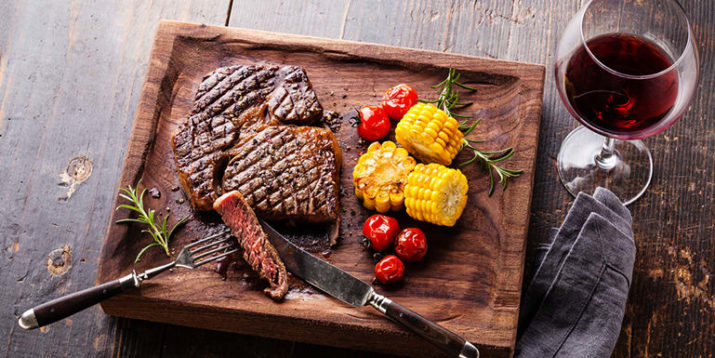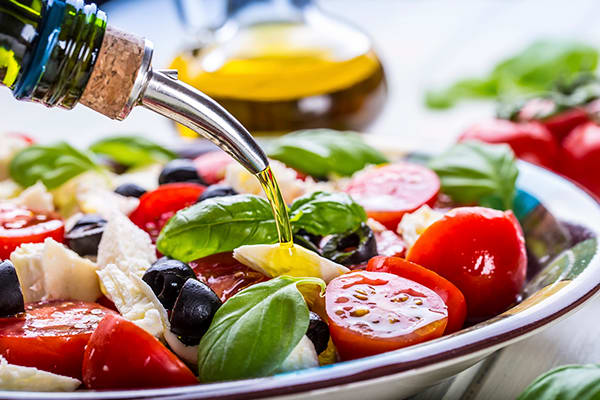Did You Know Steak and Red Wine Are Healthier Together?

Just like Brad and Angelina or Kanye and Kim, certain foods just belong together. It’s called food synergy, or food combinations: The concept that certain foods are even more nutritious when eaten together.
Think peanut butter tastes better with chocolate? Or red wine is the perfect pairing for steak? The same is true with food synergy, only the latter is more about maximizing each food’s nutrition by pairing it with its natural complement.
Food Pairings: Some Foods Are Made for Each Other
“Combining foods can increase the bioavailability of certain nutrients, making it easier for the body to absorb,” says Kristina LaRue, R.D., sports dietitian, and food blogger at Love & Zest. “When a nutrient is made more bioavailable, vitamins and minerals are ‘unlocked,’ making it easier for the body to absorb and use them.”
For example, eating a food high in vitamin D may enhance calcium absorption, while pairing wine with steak (or other proteins) may help increase zinc absorption.
LaRue is a huge believer that certain foods can actually increase each food’s overall nutrition when eaten in the right combinations. A few of her favorite pairings include salad with avocado (fat-soluble vitamins A, D, E, and K need fats to be absorbed), bell peppers and lentils (vitamin C helps to make non-heme iron from plants easier to absorb), and carrots and hummus (fats, like the ones found in hummus, make carotenoids easier to absorb).

9 Healthy Food Combinations
1. Whole Grains + Peanuts
These two foods contain 8 of the 9 essential amino acids that our bodies cannot produce. But peanuts contain the amino acid lysine that’s absent in whole grains, and whole grains contain the amino acid methionine that’s absent in peanuts. When eaten together — like with peanut butter toast — the two foods complement each other to form a complete protein source.
2. Tomatoes + Olive Oil
Tomatoes contain high amounts of lycopene, a fat-soluble antioxidant, so ditch that reduced-fat salad dressing and its added sugar. A dressing with olive oil can help increase your lycopene absorption.
3. Green Tea + Lemon Juice
A Purdue University study found that the vitamin C in lemon juice can help the body take in more of the catechins (antioxidants) in green tea.
4. Tuna + Edamame
There’s a compound in soy (genistein), that when combined with vitamin D, may help support strong bones, according to a small 2011 study on rats. Edamame, or young soybeans, may be a perfect partner for a vitamin D-packed food like tuna.
5. Steak + Red Wine
The United Nations University published a study that found that the polyphenols found in red wine can enhance zinc absorption when paired with a protein such as red meat.
6. Dark Chocolate + Raspberries
Research shows that the flavonoid in raspberries (quercetin) combined with the flavonoid in dark chocolate (catechin) may help maintain a healthy heart. Simply add a chocolate morsel into the center of a raspberry and enjoy!
7. Yogurt + Asparagus
The healthy bacteria found in yogurt that aids in digestion is amped up when eaten with a food containing high amounts of inulin, a type of fiber found in foods like asparagus, artichokes, garlic, and chicory root. Research suggest inulin may aid in the absorption of calcium, which is essential for healthy bones. Consider dipping blanched asparagus spears in a few tablespoons of Greek yogurt to reap the powerful effects of this food combo.
8. Beef + Carrots
Carrots contain high levels of vitamin A, which plays an important role in cell growth and maintaining good vision. A 2002 study suggests that vitamin A and zinc (available in meat) have a “synergistic” relationship: The lack of zinc limits the bioavailability of vitamin A, so eating them together may increase your body’s absorption of vitamin A.
9. Rice + Vinegar
Although rice is known to increase blood sugar levels, adding vinegar can lower the glycemic load of rice between 20 to 30 percent.
Food synergy isn’t an exact science, but it may help explain why your tastebuds just know which foods to eat together, for both flavor and nutrition.
